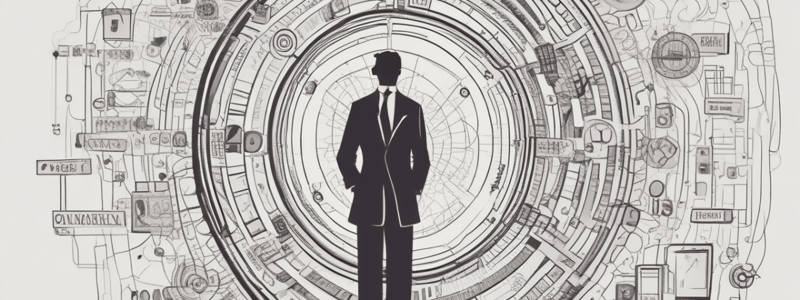Podcast
Questions and Answers
What is organizational culture defined as?
What is organizational culture defined as?
- A system of shared job descriptions and responsibilities
- A system of shared assumptions, values, and beliefs (correct)
- A system of shared policies and procedures
- A system of shared goals and objectives
What is the term for a culture that emerges within different departments, branches, or geographic locations?
What is the term for a culture that emerges within different departments, branches, or geographic locations?
- Departmental culture
- Workplace culture
- Subculture (correct)
- Organizational culture
Why may different subcultures arise within an organization?
Why may different subcultures arise within an organization?
- Due to differences in employee personalities
- Due to differences in management styles
- Due to both the personal characteristics of employees and managers, as well as the different conditions under which work is performed (correct)
- Due to the differences in job descriptions and responsibilities
Which of the following is an example of a subculture?
Which of the following is an example of a subculture?
What is a characteristic of the manufacturing department's culture?
What is a characteristic of the manufacturing department's culture?
How many different subcultures were uncovered in a single police organization in a research study?
How many different subcultures were uncovered in a single police organization in a research study?
What is the primary reason why managers need to understand subculture values?
What is the primary reason why managers need to understand subculture values?
What is a counterculture?
What is a counterculture?
According to Schein, what is the deepest level of organizational culture?
According to Schein, what is the deepest level of organizational culture?
What is the purpose of observing an organization's artifacts during an interview?
What is the purpose of observing an organization's artifacts during an interview?
What is the outcome of differences in basic assumptions between departments or subcultures?
What is the outcome of differences in basic assumptions between departments or subcultures?
What is the primary difference between a subculture and a counterculture?
What is the primary difference between a subculture and a counterculture?
What is the relationship between employee perceptions regarding subcultures and employee commitment?
What is the relationship between employee perceptions regarding subcultures and employee commitment?
What is the purpose of understanding an organization's culture?
What is the purpose of understanding an organization's culture?
What is an example of an artifact that reflects an organization's values?
What is an example of an artifact that reflects an organization's values?
Why is it important for employees to understand the type of subculture in their department?
Why is it important for employees to understand the type of subculture in their department?
What is one way to uncover the values and assumptions that shape an organization's culture?
What is one way to uncover the values and assumptions that shape an organization's culture?
What is the benefit of having a rare and hard-to-imitate organizational culture?
What is the benefit of having a rare and hard-to-imitate organizational culture?
According to Kihlstrom, what is as important as strategy in terms of organizational performance?
According to Kihlstrom, what is as important as strategy in terms of organizational performance?
What is an example of a company that may benefit from a culture that encourages innovativeness and adaptability?
What is an example of a company that may benefit from a culture that encourages innovativeness and adaptability?
What is a potential consequence of having the 'wrong' culture in an organization?
What is a potential consequence of having the 'wrong' culture in an organization?
Why is culture a more effective control mechanism for dictating employee behavior than organizational rules and regulations?
Why is culture a more effective control mechanism for dictating employee behavior than organizational rules and regulations?
What is the benefit of having a culture of respect, civility, and inclusion in the workplace?
What is the benefit of having a culture of respect, civility, and inclusion in the workplace?
What is the main reason for adapting your communication style?
What is the main reason for adapting your communication style?
What is conflict management?
What is conflict management?
What is the collaborating conflict management style?
What is the collaborating conflict management style?
Which of the following can create conflicts in organizational culture?
Which of the following can create conflicts in organizational culture?
What is the purpose of aligning values and goals with the vision and mission of the organization?
What is the purpose of aligning values and goals with the vision and mission of the organization?
Why is it important for organizations to have people who understand conflicts and know how to resolve them?
Why is it important for organizations to have people who understand conflicts and know how to resolve them?
How can employees be encouraged to embrace and benefit from change and innovation?
How can employees be encouraged to embrace and benefit from change and innovation?
What is the outcome of not establishing clear rules, policies, and procedures in an organization?
What is the outcome of not establishing clear rules, policies, and procedures in an organization?
What is essential for resolving conflicts generated by different values and goals?
What is essential for resolving conflicts generated by different values and goals?
Which conflict management style is used when it is critical to maintain all parties' relationships or when the solution itself will have a significant impact?
Which conflict management style is used when it is critical to maintain all parties' relationships or when the solution itself will have a significant impact?
What is the outcome of using the competing conflict management style?
What is the outcome of using the competing conflict management style?
What is the purpose of the accommodating conflict management style?
What is the purpose of the accommodating conflict management style?
When is the accommodating conflict management style used?
When is the accommodating conflict management style used?
What is the outcome of using the compromising conflict management style?
What is the outcome of using the compromising conflict management style?
What is one of the most common sources of conflict in organizational culture?
What is one of the most common sources of conflict in organizational culture?
What can lead to misunderstandings, stereotypes, discrimination, and resentment among employees?
What can lead to misunderstandings, stereotypes, discrimination, and resentment among employees?
Why can communication styles lead to conflict in organizational culture?
Why can communication styles lead to conflict in organizational culture?
What is the goal of using the avoiding conflict management style?
What is the goal of using the avoiding conflict management style?
What can happen if avoidance is used in place of proper conflict resolution?
What can happen if avoidance is used in place of proper conflict resolution?
Flashcards are hidden until you start studying



